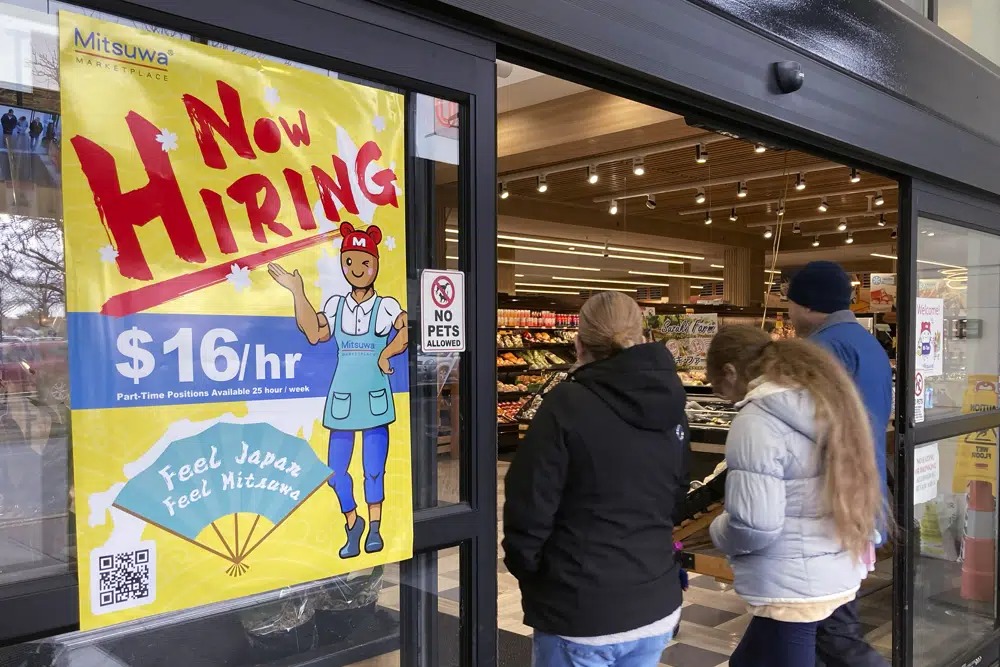America’s employers added a substantial 311,000 jobs in February, fewer than January’s huge gain but enough to keep pressure on the Federal Reserve to raise interest rates aggressively to fight inflation.
The unemployment rate rose to 3.6%, from a 53-year low of 3.4%, as more Americans began searching for work but not all of them found jobs.
Friday’s report from the government made clear that the nation’s job market remains fundamentally healthy, with many employers still eager to hire. Fed Chair Jerome Powell told Congress this week that the Fed would likely ratchet up its rate hikes if signs continued to point to a robust economy and persistently high inflation. A strong job market typically leads businesses to raise pay and then pass their higher labor costs on to customers through higher prices.
February’s sizable job growth shows that so far, hiring is continuing to strengthen this year after having eased in late 2022. From October through December, the average monthly job gain was 284,000. That average has surged to 351,000 for the past three months.
Some economists pointed to other data in Friday’s report that suggested that the job market, while still hot, may be better balancing employers’ need for workers and the supply of unemployed people. More people have been coming off the sidelines to seek work, a trend that makes it easier for businesses to fill the millions of jobs that remain open. The proportion of Americans who either have a job or are looking for one has risen for three straight months.
With more potential hires to choose from, employers seem under less pressure now to dangle higher pay to attract or retain workers. Average wage growth slowed in February, rising just 0.2%, to $33.09, the smallest monthly increase in a year. Measured year over year, though, hourly pay is up 4.6%, well above the pre-pandemic trend. Even so, that’s down from average annual gains of about 5% last year.
What the Fed may decide to do about interest rates when it meets later this month remains uncertain. The decision will rest, in part, on its assessment of Friday’s jobs data and next week’s report on consumer inflation in February. Last month, the government’s report on January inflation had raised alarms by showing that consumer prices had reaccelerated on a month-to-month basis.
Ahead of the February jobs data, many economists had said they thought the Fed would announce a substantial half-point increase in its key short-term interest rate, rather than a quarter point hike as it did at its meeting in February. Friday’s more moderate hiring and wage figures, though, led some analysts to suggest that the central bank may not need to move so aggressively at this month’s meeting.
“There’s clear signs of cooling when you dig deeper into the numbers,” said Mike Skordeles, head of economics at Truist, a bank. “I think it makes the case for the Fed to say … we’ll still hike rates, but we’re not going to do” a half-point hike.
The Fed’s final determination, though, will rest heavily on Tuesday’s report on consumer prices.
“Everything now hinges on February’s CPI report,” said Paul Ashworth, an economist at Capital Economics.
Nearly all of last month’s hiring occurred in services industries, with a category that includes restaurants, bars, hotels and entertainment adding 105,000 jobs, its second straight month of strong gains. Warmer-than-usual weather likely contributed to the gain. With the weather likely allowing more building projects to continue, construction companies added 24,000 jobs.
Retailers added more than 50,000 jobs last month, health care providers 63,000. Local and state governments — some of them flush with cash from stimulus programs — added 46,000 jobs.
Much of that job growth reflects continuing demand from Americans who have been increasingly venturing out to shop, eat out, travel and attend entertainment events — activities that were largely restricted during the height of COVID.
In contrast to the solid services hiring, manufacturers cut 4,000 jobs. And a sector that includes technology and communications workers shed 25,000 jobs, its third straight month of losses. It is a sign that some of the announced layoffs in the economy’s tech sector are being captured in the government’s data.
Last month, the government reported a surprising burst of hiring for January — 517,000 added jobs — though that gain was revised down slightly to 504,000 in Friday’s report. The vigorous job growth for January was the first in a series of reports to point to an accelerating economy at the start of the year. Sales at retail stores and restaurants also jumped, and inflation, according to the Fed’s preferred measure, rose from December to January at the fastest pace in seven months.
The stronger data reversed a cautiously optimistic narrative that the economy was cooling modestly — just enough, perhaps, to tame inflation without triggering a deep recession. Now, the economic outlook is hazier.
High borrowing rates have cratered the housing market, with home sales having dropped for 12 straight months, a consequence of the average mortgage rate nearly doubling over that time.
Hiring at February’s pace is still about triple the level the Fed would prefer. Job gains of about 100,000 a month would be just enough to keep up with population growth and prevent unemployment from rising. A figure that low would also mean that employers weren’t so desperate for workers and wouldn’t have to keep raising wages.
Higher pay is great for employees, of course. But Fed officials say it is contributing to higher inflation, particularly in labor-intensive service industries like restaurants, health care and hotels.
(AP)











